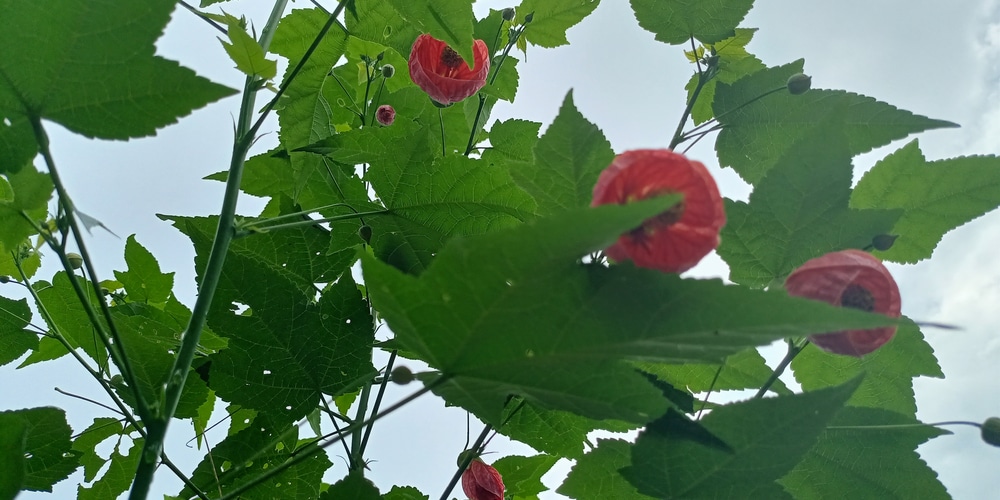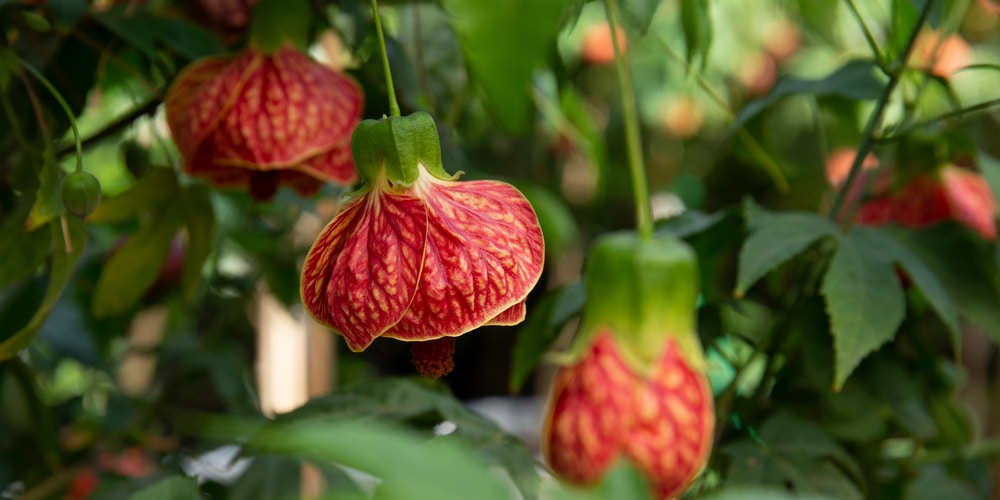A hardy evergreen shrub with yellow-orange, lantern-shaped flowers, the Abutilon ‘Kentish Belle’ is a hybrid of the megapotamicum species from which the growth habit and flower shape have been inherited.

| Botanical Name | Abutilon ‘Kentish Belle’ |
| Common Name | Abutilon |
| Plant Type | Perennial |
| Flower Color | Bell-shaped yellow-orange flowers set on red calyx |
| Size When Mature | 96 inches |
| Bloom Time | Late spring |
| Sun Requirements | Full sun |
| USDA Hardiness Zones | 9 to 10 |
| Soil PH Range | 5.5 to 6.5 |
| Soil Type | Well-drained, with loam or sand |
| Water Needs | Medium |
| Native Area | Africa, Australia, and South America |
What you Need to Know About The Abutilon ‘Kentish Belle’
Abutilon ‘Kentish Belle’ is a compact shrub with dark green, ovate leaves and pendulous, lantern-shaped flowers in yellow and orange with a red calyx. The flowers begin showing late spring through fall.
‘Kentish Belle’ adds a gorgeous piece to your landscape and isn’t fussy about its soil conditions. The fast-growing species is non-toxic to pets, humans, and livestock.
How to Care for Abutilon Kentish Belle
Here’s everything you need to know about growing and caring for a thriving Kentish Belle Abutilon
Light
Abutilon ‘Kentish Belle’ grows best in full sun conditions, but the shrub can tolerate partial shade in hotter and sunnier regions.
Gardeners who want to get maximum blooms should plant their Kentish Belle where they can get bright sunlight throughout the day. It may be a good idea to put it in a sheltered place out of strong winds and frost pockets.
Water and Soil Needs
Kentish Belle Abutilon can grow in virtually any soil type as long as it drains well and doesn’t get waterlogged for too long. To achieve the best plant health though, you’ll want to put your Kentish Belle in an organically-rich loam medium with plenty of compost.
The semi-evergreen shrub can tolerate any soil pH. Young Abutilons will want plenty of watering during their first year, so make it a point to irrigate regularly and thoroughly. As time passes you should still water but only to keep the soil moist.
Temperature Requirements
Abutilon ‘Kentish Belle’ is sensitive to extreme cold and frost, and prefers a warm environment. It will thrive in a well-lit spot under filtered light with the ideal temperature of 70F at daytime and around 60F during nighttime. In the US, the shrub can be grown in zones 9 and 10 where the climate is warm and the winters are mild.
Fertilizer
The best fertilizer to use on an Abutilon ‘Kentish Belle’ is a balanced, water-soluble fertilizer.
Abutilons prefer to get well-rounded nutrition and quickly too since they’re fast growers. A balanced 18-18-18 should suffice to keep the plant healthy and continue producing flowers.
Every two weeks you can feed your Kentish Belle a half-strength solution, alongside maintenance pruning. Remove dead branches and leaves so your Kentish Belle stays nice and presentable.
Common Diseases
‘Kentish Belle’ Abutilon can suffer from several pests and diseases, including scale, aphids, mealybugs, glasshouse red spider mites, and glasshouse whitefly.
Prevention and early detection are the best solutions to keeping these pests at bay. Regularly spray your plant with a natural pesticide, such as neem oil or similar products. In addition, you should regularly inspect the leaves and flowers for signs of early infestation.
Abutilon Kentish Belle Propagation
Propagating your ‘Kentish Belle’ can be done by collecting flower seeds or via softwood cuttings.
Healthy softwood cuttings can be taken anytime during the growing season. Choose a healthy specimen that’s around 8 to 12 inches and one that has 6 to 8 leaf nodes.
Remove the bottom leaves and stick the cutting in a well-draining sandy soil mix. Keep the container in a location that gets bright indirect light and wait for the roots to form in around 4 to 6 weeks.
Related Article: Best Time of Year to Plant Shrubs
